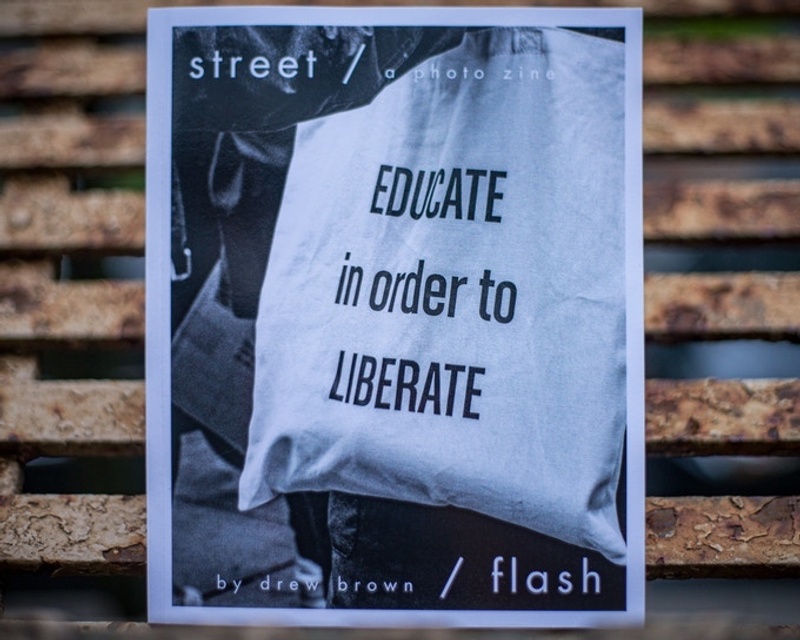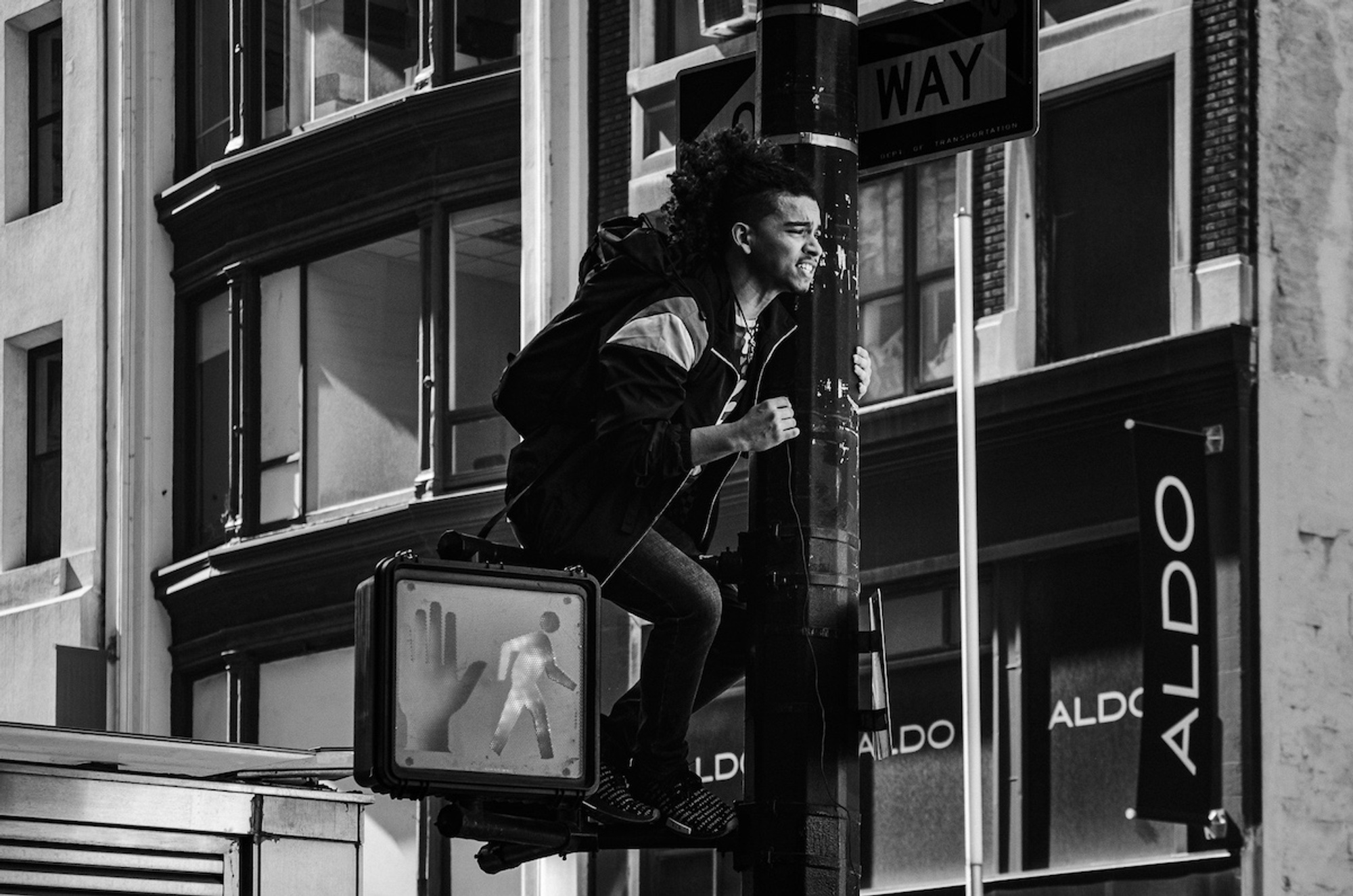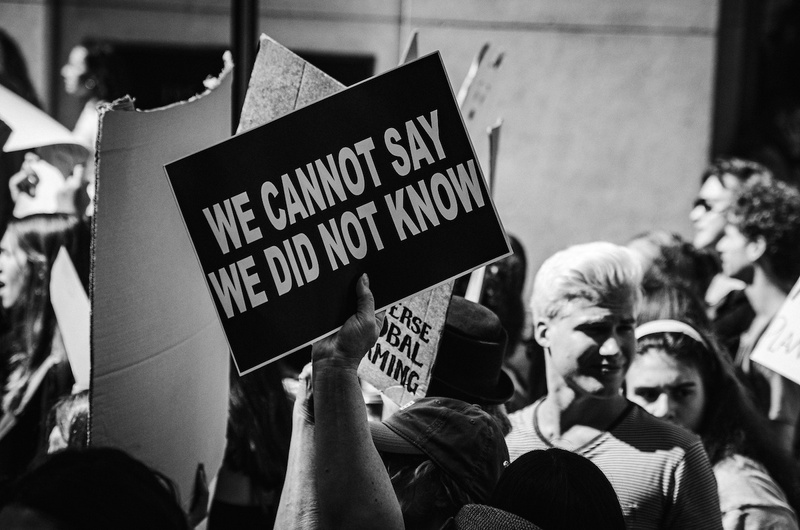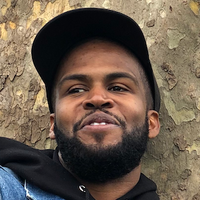On zines and teen uprisings
Prelude
Drew Brown is a Bronx-based, first-generation photographer whose work features social gatherings from prison abolition protests to music festivals. His first Kickstarter campaign—Street Flash Photo Zine—features shots from three different climate strike marches in New York City and his thoughts on how climate justice, racial justice, and youth culture intertwine.
This conversation is part of our Signs of Change series highlighting creators who have previously launched activist posters, broadsides, stickers, and zines on Kickstarter and encouraging newcomers to participate in Kickstarter’s open call for projects.
Conversation
On zines and teen uprisings
Photographer Drew Brown on youthful energy, joyful protest, and why you really need to check your first proof before ordering prints.
As told to Katheryn Thayer, 1335 words.
Tags: Photography, Design, Activism, Process, Independence, Politics, Production.
Was Street Flash the first zine you ever made? What brought you to the project?
Yeah, I first learned about zine making from an art show. The thing that appealed to me about zines, especially photo zines, is that they can be artwork, a call to action—literally whatever you want them to be—and they’re also incredibly accessible, very cheap. They’re really easy to make, all you really need is paper.
You’ve done a bunch of different types of photography before—portraits, cityscapes, shots from music festivals, lots of different protests. Why did you make your first zine about climate marches?
I’ve photographed a bunch of climate strikes throughout last year, all of them in New York. So I have a ton of photos of those, I have the material there to make a great piece of work. That was the practical side, but it’s also that the climate strike seems like something that can appeal to everyone because it’s something that affects everyone, especially the younger generation. We all have a role to play, whether it’s going out in the streets to protest or just changing some of our daily habits.

The number of young people out at climate marches is really striking, and they seem to do activism really differently—a lot of meme language on signs, a lot of energy. What were some of the things that you saw on the ground that you feel like are defining this current moment?
Right, yeah. I see a lot of kids, and they’re just having fun. It’s not to say that no one else has fun in protests, but it seems like there was just this beautiful nature that’s really contagious. It’s just a great environment to be in, like, “Yeah, we might be doomed in the future, but we have each other, we’ve got each other’s backs.” I’m only 21, but there are kids out there, 16, 17, 18 years old that are going out there and being really involved, organizing some of these actions. It’s inspiring.
Right, you definitely feel a sense of joy, despite the existential threat at these marches. What place do you think joy has in activism?
I do think that if you’re involved in activism, you have to go into it with the belief that you will achieve that change. I feel like that’s where that joyful nature comes in. Being able to imagine a future that’s better for everyone with a group of people who are like minded? That’s joy.
How do you think that the youth presence plays into that? How do you see young people engaging differently than older people?
Right—things like TikTok, social media, memes. I’ve seen a lot of signs of memes, I found they’re just incredibly creative and sometimes incredibly simple. One of my favorite signs just says, “Bruh.” I feel like those four letters alone on that poster board? It says a lot.

How would you describe your approach to photographing?
For most if not all of the protests that I capture, I almost always take the photos from the perspective of the protesters. When I say that, I mean I’m marching with them. I’m not just hanging out with the other photographers in the media section, taking photos of the leaders and whatever. I get shots that media reps don’t really get, and people might say that I’m a photojournalist, but I don’t really try to claim myself as one, because I don’t really just capture an event. I capture bits and pieces of different narratives.
Journalists are often expected to have this cold, measured response to things happening around them, to not have an opinion on the issues they’re covering. It seems like you do have an opinion, and that you take a more activist stance.
Yeah, totally. These issues that I capture, I’m passionate about them. Things like climate change, immigration, women’s rights, LGBTQ rights, prison reform, et cetera, et cetera. These are issues that I care about, and yeah, the typical journalists are just assigned to go to certain locations and document that. Whereas I’m looking for events and protests thinking, “Dang, would I go to this protest if I didn’t bring my camera with me?” If the answer is yes, then that’s a protest that I want to go photograph.
It seemed from your Kickstarter campaign, you also wrote a little about your experience, what kind of text is in your zines?
Street Flash, this first issue, is a project that was born during this COVID-19 lockdown. The stories are intertwined. COVID-19 and climate change are both crises that have affected the whole world, but these days, only one of them gets the attention.
The coronavirus is more of an immediate threat. But climate change is going to affect a lot more people. Millions—billions—of people, and many people are already dealing with it.
I also tied in a bit of how both climate change and COVID-19 seem to mostly impact communities of color. I live in the Bronx. The South Bronx in particular has an air pollution issue, and children and adults have respiratory issues like asthma. Asthma happens to be one of the conditions that may lead to a higher chance of hospitalization or death from the coronavirus.
I’ve noticed climate activists have definitely shown up in solidarity with racial justice, because honestly we can’t have environmental justice without racial justice. We can’t create transformative change with our climate if Black and Brown people are still left behind.
I just wanted to highlight how all of these issues tie together.

Is there anything else you want to say about the impact you hope your zine has?
I hope that the photos inspire folks to say, “If the kids are doing it, why can’t I?” Kids are skipping school for this. Greta Thunberg is literally taking every Friday off. Students all over the world are trying to let people know this is urgent, to get lawmakers to act.
But sometimes we can’t. A lot of us aren’t able to go to the streets every Friday and protest. In the zine, I’ve provided resources to educate yourself: podcasts, documentaries, books, and other tools, as well as suggestions on how you can be active if you can’t show up to a climate strike, like joining a mutual aid organization or making recurring donations.
What’s your advice for other people who are coming into making their first zine or printed photography project? What are some things you learned along the way that you wish you knew earlier?
Go in there with a plan for your timeline and budget, but understand that things just pop up sometimes. For instance, the zine had an earlier copy that I was going to put out, but I had to just scrap that. It didn’t come out right: The images all had a greenish tint, which is like “Haha, funny, environmental, or whatever.” Thankfully, that was just a proof, I didn’t print the whole batch like that.
That’s another thing: Make sure you get a physical proof. Sure, a hard copy proof costs a lot more than a soft copy—an online digital copy—but you should definitely be able to look at the flaws and see if everything’s a hundred percent perfect before you start sending things out. You do not want to send out a product that turns out it’s not really what you intended it to be.
Things come up, and you just have to work ahead of that.
Drew Brown’s top 5 protest songs:
“Total Football” by Parquet Courts
“Alright” by Kendrick Lamar
“Killing in the Name Of” by Rage Against the Machine
“Blood of the Fang” by clipping.
“This Is America” by Childish Gambino
- Name
- Drew Brown
- Vocation
- Photographer
Some Things
Pagination



